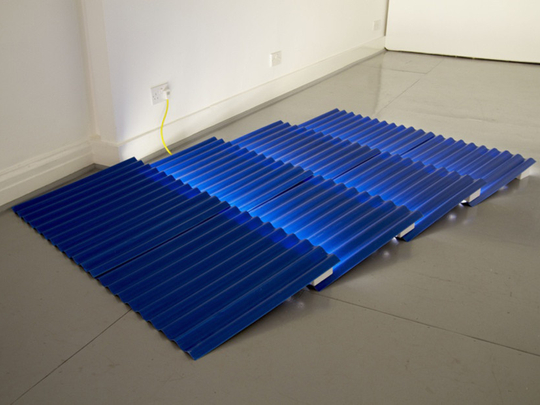
Lawrie Shabibi gallery’s summer exhibition, “Unseen”, brings together recent works by Adel Abidin, Farhad Ahrarnia, Asad Faulwell, Driss Ouadahi, Nathaniel Rackowe and Shahpour Pouyan. The artists have used a variety of materials and media to explore themes ranging from preservation of ancient monuments to the influence of urbanisation on contemporary society.
In his previous videos, Abidin, an Iraqi-Finnish artist based between Amman and Helsinki, has addressed the subjects of migration and global, social, political, and cultural issues that traverse a complex landscape of identity, memory, exile, violence and war. But his latest video “Michael” deals with a more universal theme. The video presents an imaginary scenario where Michael Jackson is resurrected from the dead and appears for an interview on a popular talk show, while thousands of adoring, hysterical fans watch the live telecast in New York’s Times Square and other places across the globe.
“In the contemporary world celebrities such as Hollywood actors and pop singers are put on a pedestal as our modern day messiahs. Thanks to media promotion of pop culture, they have become extremely influential. In this video Michael’s replies to the host, and his speech are nothing but a compilation of the lyrics of his well-known songs, but he is presented as a prophetic figure that unveils the universal truths about our world. This false prophet is thrown on a television talk show, the ultimate pop culture altar; and thousands of fans from around the world eagerly listen to what he has to say about existential topics such as the mysteries of death, afterlife and immortality, and even other subjects such as preventing climate change, and what world leaders should do to make the future better. The work thus speaks about our gullibility and blind belief in prophetic symbols created by pop culture, and the intensity with which we follow them even after their death,” the artist says.
Colour Correction 2 by Yazan Khalili, 2007-10
Pouyan’s “Memory Drawings” series comprising 39 mixed media drawings on paper explores ideas of human preservation and perception of images. The Iranian artist was fascinated by the extraordinary shape of the tomb of the 11th century Muqarnas dome of Sharaf ad-Dawla, a Shi’ite mausoleum near Mosul in Iraq. An image of this monument has been hanging in his studio for a long time, and he hoped to visit the place one day. However, those hopes were dashed when Daesh (the self-proclaimed Islamic State of Iraq and the Levant) destroyed the monument in October 2014.
Realising that he would never get to see the monument, the artist decided to preserve this lost legacy by making drawings of the tomb from memory, emphasising the details of the structure, form and ornamentation. He made one drawing every week, without looking at the original image on his studio wall or his own previous drawings. The series is thus a personal documentation of the inability of the human mind to document things accurately. It alludes to the practices of oral history and the drawings of ancient explorers, highlighting the processes by which an experience changes and evolves over time in our minds, and the cross-fertilisation of ideas and images across cultural borders.
Cross-cultural exchange is also the theme of Ahrarnia’s “Khatam” series, where he has used the traditional Iranian decorative micro-mosaic technique to create abstract artworks. The three new works he is showing are based on the minimalist compositions of Malevich, thus referencing the influence of Russian modernism on the art and architecture of mid-20th century Iran.
Les Femmes D'Alger #62 by Asad Faulwell, 2016
Faulwell has also combined the Iranian tradition of geometric design with brightly coloured, elaborate repetitive arrangements reminiscent of Henri Mattise’s decorative patterning in his mixed media works from the ongoing “Les Femmes D’Alger” series. The works are an homage to the forgotten Algerian women who fought alongside men in the war of independence from French occupation between 1954 and 1962. The artist had to do a lot of research to find a few photographs of these courageous women, who endured arrest and public trials, but whose contribution to their country has largely been forgotten. He has used bright colours, intricate decorative patterns, and religious imagery to give his poetic collaged paintings of the women the look and feel of devotional shrines to honour them. Yazan Khalili and Larissa Sansour are Palestinian artists who have addressed Palestinian issues, but in different ways. Khalili’s photographic works from his “Colour Correction” and “Areas A, B, and C” series deal with the trauma of losing the homeland in 1948. The pictures of scenic villages and towns highlight the sense of separation between the shared memories of the older, exiled generation and the present reality of Palestine.
Sansour on the other hand confronts the issue of creating an independent state for Palestinians in her acclaimed “Nation Estate” series by presenting an imaginary, sci-fi based narrative about a Palestinian State based in a futuristic skyscraper, whose residents can travel from one Palestinian city to another by elevator. She is showing a poster, which is a tongue-in-cheek advertisement inviting prospective buyers to “live the high life” in this idyllic real estate development.
Invitation to the Voyage by Farhad Ahrarnia, 2015-16
Oudahi and Rackowe are both interested in exploring the urban environment. Oudahi’s paintings depict dream-like perspectives of urban structures, blurring the line between reality and his own imagination. In contrast, Rackowe has used construction materials such as corrugated roofing sheets and fluorescent lights to create an installation that explores the idea of home and the impact of urbanisation in contemporary society.
Jyoti Kalsi is an arts-enthusiast based in Dubai.
“Unseen” will run at Lawrie Shabibi gallery until September 10.












